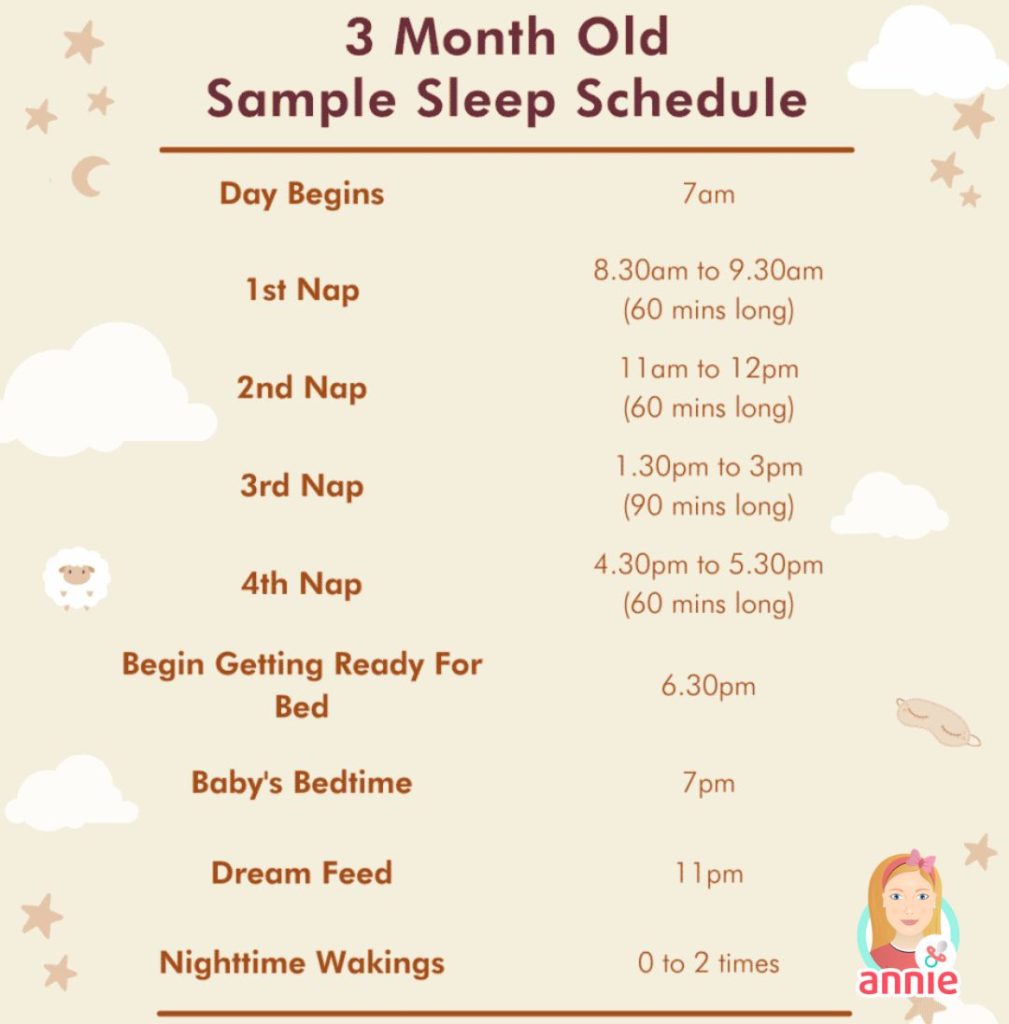
Crafting a 3-Month-Old Sleep Schedule: A Comprehensive Guide for Parents
- Created:
7. 11. 2023 - Updated:
9. 11. 2023
Admit it:
Getting your baby to follow a 3-month-old sleep schedule sounds like a difficult task.
For one thing:
Infant sleep cycles are challenging to predict.
Plus, all babies are different, so it can be a hassle to know what fits your child.
Not to worry:
Like all baby essentials, the 3-month-old sleep schedule is not a one-size-fits-all endeavor. So, you can draft a sleep schedule for your 3-month-old according to their cues.
With that said:
In this guide, I’ll explain how to craft a 3-month-old sleep schedule from scratch and using a sample.
Ready?
The Importance of Sleep for a 3-Month-Old
Get this:
Babies aren’t born with an established circadian rhythm. This means that the natural rhythms they need to distinguish naps from nighttime sleep are mostly absent till they hit the 3-month mark.
As a result:
Newborns, from their first night at home, sleep a whole lot.
In fact:
Up until the baby hits the 3-month mark, they will spend most of their time sleeping. But it’s completely normal.
Around three months of age, your baby starts to develop an understanding of daytime and nighttime.
As such:
They take shorter naps during the day and sleep better at night.
Evidently:
Three months marks a turning point in the life of an infant. From their developing circadian rhythms to their increased understanding of life’s conditions, it’s a lot to process.
For this reason:
They need long, comfortable, and safe sleep.
Essentially:
Sleep encourages both physical and mental development in 3-month-olds. It helps them let off the steam of processing so much information and prepares their brains to take in more information.
Furthermore:
In 3-month-olds, sleep is quite vital to help them develop cognitive skills like memory and language.
Not to mention:
As your baby sleeps, their body produces Human Growth Hormones (HGHs), which help them grow physically.
According to PregnancyBirth&Baby, babies around 3 months old sleep for about 12-15 hours in total per day.
Of course:
Your baby might sleep for longer or less, but they should spend an average of around 14 hours sleeping per day.
Note:
If you’re concerned about your baby’s sleep patterns, be sure to consult an expert or pediatrician for help immediately.
Identifying Sleep Windows
Just as babies have wake windows, they also have sleep windows.
Fundamentally:
A baby’s sleep window is the time they spend asleep. It can either be long or short, depending on your baby’s body and how comfortable their sleep environment is.
As we all know:
When babies begin to enter their sleep window, they express signs of tiredness. These signs tell you that it’s time to put them to bed so they can sleep properly.
So:
To identify your baby’s sleep window, you have to look out for signs of tiredness or exhaustion.
And while there’s no magic trick to it, you can identify your baby’s sleep windows by:
- Looking out for droopy eyes
- Paying attention to how often they yawn
- Listening to their reduced cooing or babbling
- Observing the baby for reduced mobility
More often than not:
When your baby shows two or more of these signs, it’s a signal that they’re ready to hit the bed.
Now:
You can help your baby settle into a particular sleep window. All it takes is for you to observe their cues and set up a routine accordingly.
For example:
If your baby often gets tired around 7:00 pm, you can prepare them for bed around this time. By doing so, you create a routine that your child is comfortable with.
Creating a 3-Month-Old Sleep Schedule: Step-by-Step Guide
As we’ve established:
There’s no one way to draft a 3-month-old sleep schedule because all babies are different. And sleep schedules differ with your baby’s preferences and natural cues.
Now:
While this might seem like a difficult task, creating a 3-month-old sleep schedule is quite easy. Here’s how:
1. Observe Your Baby’s Natural Rhythms
Fact:
It is never a good idea to force your baby into a specific sleep pattern.
I’ll explain:
At three months, your baby is just developing steady natural sleep rhythms. And forcing them to adapt to a particular sleep pattern can disrupt these rhythms.
Once this happens, your baby might begin to fight sleep or have difficulty sleeping properly. In turn, this could affect their health and development negatively.
For this reason:
Before working out a sleep schedule for your baby, you must first observe their natural sleep rhythms.
Basically:
Internal waves, known as circadian rhythms, regulate how long, how often, and how deeply your baby sleeps. These rhythms depend on hormone interaction in their body and how they react to external factors like light and darkness.
In essence:
By observing your baby’s natural rhythms, you learn about how long, how often, and at what time they sleep. This enables you to know how to draft a sleep schedule that would fit these patterns.
2. Establish a Bedtime Routine
Fact:
Babies love a good routine. And 3-month-olds are no different.
As such:
When it’s almost time for them to get to bed, it’s always a good idea to establish a bedtime routine.
Ultimately:
Bedtime routines set the mood for your 3-month-old to fall asleep. It’s basically like an invisible clock that tells their body that it’s time to go to bed.
Now:
Establishing a bedtime routine for your baby doesn’t have to be a complicated process. You can simply turn off the bright lights and turn on their night light to set the mood. Or you can pick them up and start patting or rocking them.
In doing so:
Your baby can sense that it’s nearing their bedtime, so their brain begins to prepare them to sleep.
Additionally:
You can run a soothing bath for the baby or sing them a lullaby as part of their bedtime routine. This keeps them calm and reduces the chances of them refusing to sleep.
Not to mention:
When you sing your baby a lullaby, you bond with them.
That’s right!
If you add a lullaby to your baby’s bedtime routine, you familiarize them with your voice.
This way, even if it’s not time for bed, they can recognize you just by how you sound. Plus, this is a brilliant way to stimulate their brain function with memory and recognition.
3. Set a Consistent Wake Time
Check this out:
Maintaining a consistent wake time for your baby can help them sleep better.
It might sound strange, but hear me out.
Slumber is really good for your baby, but you can overdo it. When this happens, you might notice your baby getting overtired or exhausted even after a 3-hour-long nap. And frankly, this isn’t a good sign.
With time:
This overtiredness can cause stress in your baby, which can prevent them from sleeping properly.
Now, don’t get me wrong:
Forcing your baby to wake too early can also lead them to overtiredness. So it’s never a good idea to make your baby wake too early or too suddenly.
Instead:
You should find out what works for them and tailor their sleep schedule accordingly.
To do this, monitor their wake windows, observing how long they spend awake and at what time they wake. This gives you a blueprint of how their body works and what sleep duration and time you should use.
Thus:
With this blueprint, you can set a wake time that your baby is comfortable with and stay consistent with it.
Once you’ve set a consistent wake time for your baby, you’ll notice them naturally settle into that routine. And with time, they won’t need your help to wake up at the stipulated time.
4. Plan Nap Times
The truth is:
It can be a challenge to plan nap times for your three-month-old.
For one thing:
At three months, your baby starts to sleep longer at night, so they might not need naps as much. Because of this, your baby might have a long nap in the morning and shorter ones throughout the day.
Now:
While it’s too soon to transition to one nap at this age, you can plan their nap times instead.
Primarily:
The whole point of planning your baby’s naps is to provide a pattern for them to adapt to. Typically, planning naps means laying down the duration and time for each nap so you can track your baby’s sleep.
Furthemore:
With a nap plan, you can properly predict if the sleep your baby gets during the day is enough for them.
Of course:
Your nap plan doesn’t have to be too rigid. There could be room for shorter or longer naps, depending on your baby’s needs.
Generally:
Three-month-old babies get around 4-5 naps daily. However, this could vary from day to day. So, while planning their nap times, you should always leave an opening for extra or fewer naps.
Also:
Since their nap durations also vary, you can adjust their nap schedules according to their natural sleep rhythms.
This way, your baby gets the perfect amount of daytime sleep to encourage their development without the risk of overtiredness.
5. Include Time for Feedings
It’s something we all know:
Hunger opposes infant sleep.
You might have experienced it:
After working so hard to put your little one to sleep at night, they wake up in the middle of their slumber.
Trust me:
You’re not the only one who gets upset when that happens. Babies also hate it when they wake up because of hunger. And they don’t hesitate to express their discomfort.
If you think about it, they can’t control their hunger cues, but you can to an extent.
I’ll elaborate:
Babies use up their food quickly. Their bodies develop at an astonishing pace, and they need nutrients to support that process.
So:
If you feed your baby far from their bedtime, they might get hungry while they’re asleep. Hence, they’d wake up crying.
However:
Incorporating feeding times into their sleep schedule at the right periods prevents this from happening.
One way to do this is by feeding them a little closer to their bedtime.
Essentially:
You just have to align their feeding schedule in a way that ensures they don’t get hungry during their sleep.
In addition:
If your baby shows signs of hunger, such as fussiness or lip smacking, ensure to feed them before bed.
Sample 3-Month-Old Sleep Schedule
Listen up:
As your baby hits 3-month-old milestones, you might have to do a lot of adapting. And seeing as they love routines so much, it can be daunting to draft feeding and sleep schedules from scratch.
The good news is:
A sample can take some of that load off your shoulders.
Don’t forget:
All babies can’t follow a certain schedule, so it’s always best to personalize your baby’s sleep schedule. So, even with a sample, you can tweak the nap times and durations to fit your baby’s specifications.
With that in mind:
Here’s a sample 3-month-old sleep schedule for a baby that wakes at 7:00 am:
| Nap | Nap Time Interval | Nap Duration | Wake Window |
|---|---|---|---|
| 1st nap | 9:00 am – 10:00 am | 1 hour | 2 hours after morning wake |
| 2nd nap | 11:30 am – 12:30 pm | 1 hour | 1 hour and 30 minutes after 1st nap |
| 3rd nap | 2:00 pm – 3:30 pm | 1 hour 30 minutes | 1 hour and 30 minutes after 2nd nap |
| 4th nap | 5:00 pm – 6:00 pm | 1 hour | 1 hour and 30 minutes after 3rd nap |
Following this schedule, the baby would start getting ready for bed around an hour and a half after the 4th nap.
If you look at the table, you’ll notice that one of the naps is an hour and 30 minutes long. This is because at three months, your baby’s nap times could fluctuate. So it’s best to leave room for longer naps.
Now:
If your baby takes more than four naps a day, you can simply add an extra nap after the fourth.
However:
You should note that each nap shouldn’t exceed two hours. This prevents your baby from oversleeping and reduces their risk of getting overtired.
Don’t forget:
When your baby wakes, ensure to feed them so they don’t get tired in the middle of the next nap.

Final Tip: Annie Baby Monitor – Your Sleep Helper for Newborns
Babies and their sleeping habits can be quite puzzling!
But don’t worry, with Annie Baby Monitor’s baby tracking feature, you can keep an eye on your little one’s sleep patterns without any hassle.
Annie Baby Monitor baby tracker allows you to keep a watchful eye on your newborn’s sleep duration. By collecting and analyzing this valuable data, you can identify patterns and create a sleep routine that suits your baby’s needs.

So, if you’re navigating the newborn sleep, let Annie Baby Monitor be your trusted sleep helper.
Conclusion
All in all:
Sleep is vital for infant well-being and devlopment and sleep schedules can help them achieve optimum sleep.
Here are the steps to creating the perfect sleep schedule for your 3-month-old:
- Observe your baby’s natural rhythms
- Establish a bedtime routine
- Set a consistent wake time
- Plan nap times for your baby
- Include time for feedings
And, of course:
You can use the sample we provided in this piece to guide your baby’s sleep schedule.
With that in mind:
If you found this article helpful, let me know in the comments. And if you have any questions or concerns, leave me a comment and I’ll respond as soon as possible.






